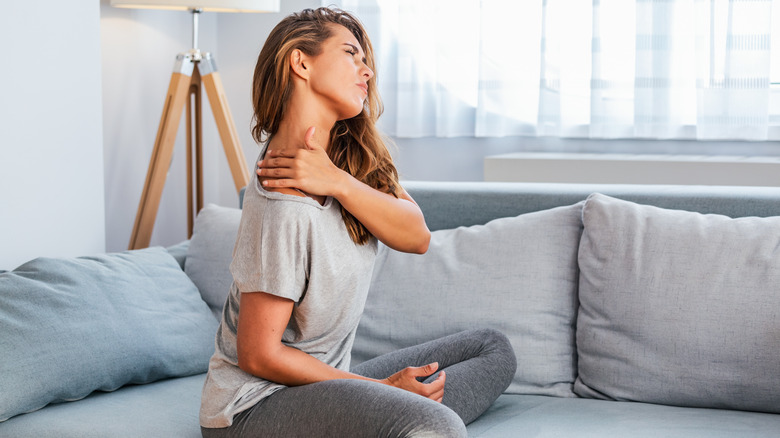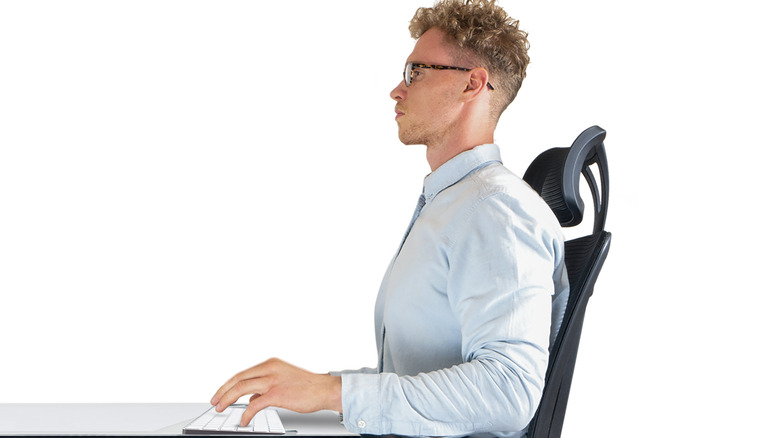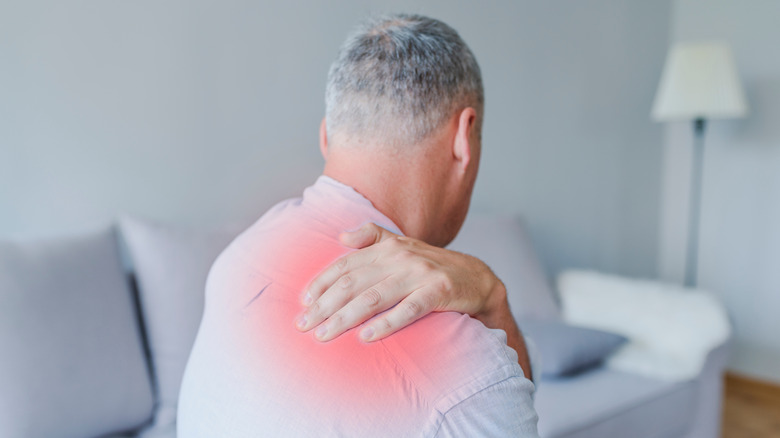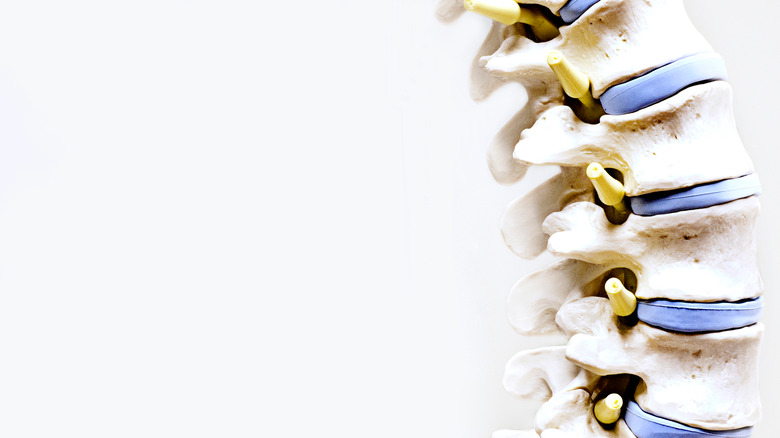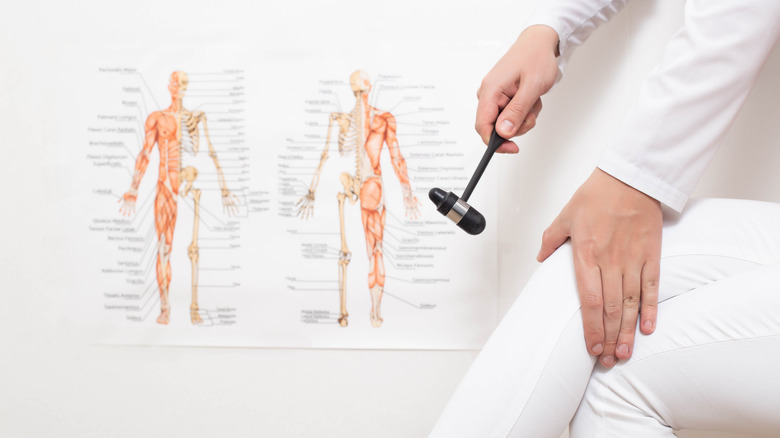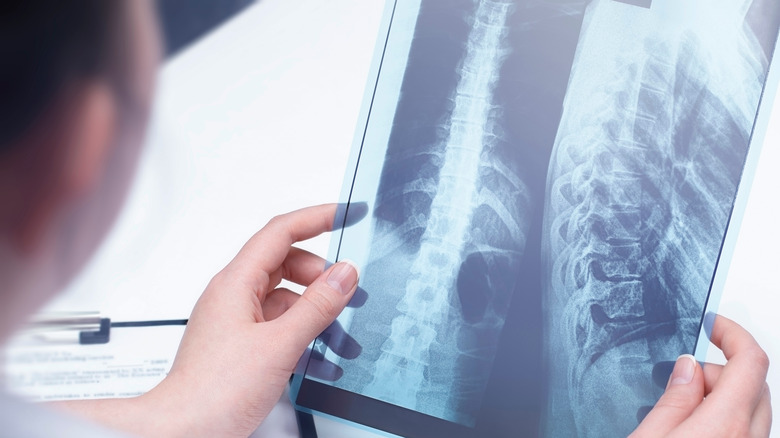What It Really Means When Your Upper Back Hurts
Do you have pain in your upper back and wonder what could have caused it? According to the American Academy of Orthopaedic Surgeons (AAOS), your spine has three sections: the lumbar spine or lower back, thoracic spine or mid to upper back, and cervical spine or neck.
Dignity Health points out that while back pain is common, upper back pain is less common than lower back pain, but that doesn't mean it can't happen. Lower back pain is more common because your lower back or lumbar spine isn't connected to anything and moves around more, while your thoracic spine is connected to your rib cage. Upper back pain is located between your shoulders. Upper back pain could happen quickly or get worse over time. You might describe the pain as stabbing, sharp, achy, dull, cramping, headaches, or muscle spasms. It can range from mild to severe and even affect your ability to move around. Determining the cause of your upper back pain is vital for treatment.
The AAOS notes that one possible cause is a spinal fracture resulting from trauma — including a car accident or fall — or weakened bones due to an underlying condition. If you're experiencing upper back pain that worsens when you move, you might need an x-ray. See your doctor to figure out if you have a break in your vertebrae. Read on for more reasons why your upper back hurts.
Bad posture
Slouching can cause upper back pain, especially if you're sitting for long periods and have a rounded back, per Spine Universe. This is one of the reasons why good posture is so important. When sitting for hours a day, like at a desk or in a vehicle, it's easy to forget about your posture and find yourself with neck, shoulder, and back pain later.
When your head is at the proper position, your head weighs about 10 pounds and puts no added stress on your back. However, when your head is forward and your neck is bent, your head gets heavier and more challenging to hold. This is called tech neck because it often happens when you look down at your phone. In addition, for every inch your head tilts forward, your head doubles in weight, putting more pressure and strain on your neck, shoulders, and back. So, if your head's tilted just 45 degrees forward, your head weighs nearly 50 pounds (via a 2014 study published in Surgical Technology International).
Harvard Health Publishing recommends imagining a straight line going through your body from the floor to the ceiling. Think of a cord pulling your body toward the ceiling. Take regular breaks and move around throughout the day, so you're not in the same position for hours on end.
Muscle strain
The middle and upper portion of your spine is comprised of 12 vertebrae with discs in between each one. These discs act as a cushion between the bones in your spine, so your bones don't rub on each other. Some ligaments and muscles help support your spine. You can have a muscle strain that could cause your upper back to hurt, according to the University of Michigan Health.
A muscle strain can be treated at home if it's not severe. Rest and slowly return to your regular movement. Use a heating pad to reduce stiffness or an ice pack to reduce swelling. Both will help with the pain. Use over-the-counter medication to reduce pain —acetaminophen or a nonsteroidal anti-inflammatory. Once you're healed, do exercises that strengthen your upper back, shoulders, and core, which can help reduce injuries and improve your posture.
Spine Universe notes you might have a headache, muscle tightness or stiffness, and pain as a result of an upper back injury. If you have an injury to the discs in your spine or one that affects your nerves, you might experience pain that goes down your legs, bowel or bladder leakage, or numbness in your legs. See your doctor to determine the cause and treatment.
Herniated disc
The discs in your spine create a cushion in between your vertebrae. A herniated disc is one that has come out from in between those bones, wholly or partially, resulting in upper back pain, numbness, and radiating pain. Since the disc could be pushing on a nerve, the symptoms could differ depending on where the herniated disc is located (via Spine-Health).
According to Columbia University Irving Medical Center, there are 12 vertebrae in your thoracic spine. Symptoms of a herniated disc can be anything from muscle spasms to muscle weakness to sciatica, similar to other medical problems. That's why it's vital to see a doctor for an evaluation and treatment. When you see your doctor, they will likely do some MRI and CT scans to look at your bones, nerves, discs, and ligaments. You're at a higher risk for herniated discs the older you are, because you are more likely to have degenerative disc disease. However, younger people can get a herniated disc from an injury or trauma.
Pinched nerve
As mentioned before, a herniated disc can result in a nerve getting pinched, but it could also be caused by changes in the spine as you age, like arthritis or an injury. The medical term for a pinched nerve is radiculopathy and can result in back pain, pain that radiates to your shoulder or arm, muscle weakness, and numbness. You may also have chest pain if it's thoracic radiculopathy — a pinched nerve in your upper back (via the American Academy of Orthopaedic Surgeons).
Pinched nerves are pretty common, affecting 85 out of 100,000 adults in the United States, per the Cleveland Clinic. Anyone of any age can get a pinched nerve, but those over 50 are more likely to experience it from the spine degeneration or arthritis. A pinched nerve can heal on its own in four to six weeks, but can sometimes turn into something more serious. Try over-the-counter pain relievers and rest. If it doesn't go away after resting, you need to see your doctor for an evaluation.
Arthritis
Your upper back pain could be a symptom of spinal arthritis — inflammation of the joints in your spine — which could affect your tendons and ligaments. The most common form of arthritis is osteoarthritis, which can also affect the spine. As a result, you may have back pain and stiffness. You may need to take pain medications, or get steroid injections, physical therapy, and in severe cases, surgery. Risk factors for spinal arthritis are age, obesity, and other health conditions — gout, irritable bowel syndrome, Lyme disease, diabetes, psoriasis, and tuberculosis (via Johns Hopkins Medicine).
The Hospital for Special Surgery adds that you might experience stiffness in the morning, limited motion, bone spurs, and deterioration of your spine. Core exercises can help, but you need to see your doctor for an evaluation. An accurate diagnosis is necessary to determine the treatment. Spinal arthritis can cause a pinched nerve or spinal stenosis, where your spinal cord is compressed. Your treatment will depend on which kind of spinal arthritis you have and whether other conditions affect it.

